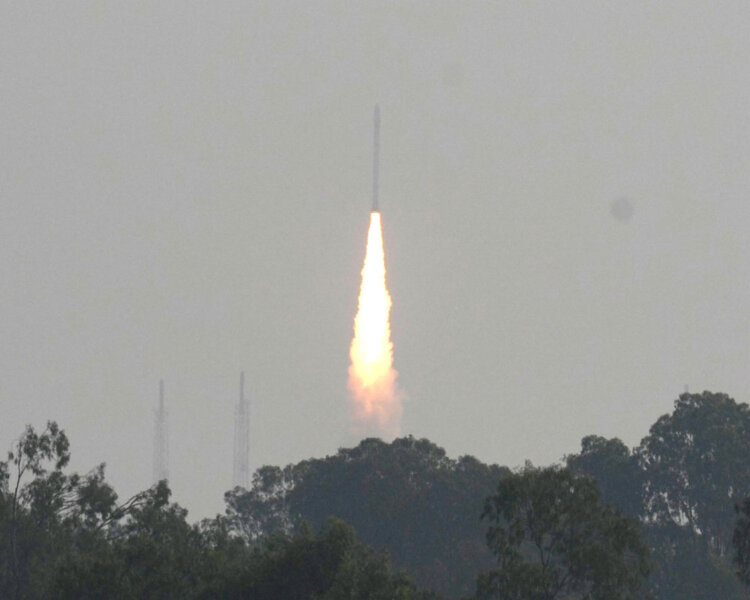On Friday, India got another rocket for satellite launch. SSLV-D2 orbited three satellites successfully with its new rocket — Small Satellite Launch Vehicle (SSLV).
On its second developmental flight, the SSLV-D2 launched an earth observation satellite-07 (EOS-07) weighing approximately 156.3 kg, as well as two others: 10.2 kg Janus-1 from ANTARIS in the United States and 8.7 kg AzaadiSat-2 from Space Kidz India in Chennai.
Following the successful launch, According to S. Somanath, Chairman of the Indian Space Research Organization, the country has one more rocket capable of launching satellites. ISRO’s GSLV rocket will launch a navigation satellite in 2023.
“The SSLV-D2 rocket has launched the three satellites successfully. The orbit achieved was good.
“All the rocket systems worked well,” said the Chairman.
Recalling the failed maiden SSLV-D1 mission last year, Somanath said: “We had a narrow miss. We have implemented corrective measures.”
S.Vinod, Mission Director said India has a new satellite launch vehicle.
“It all started in 2018 and the rocket has reached the intended destination today (Friday).”
He said last year’s SSLV-D1 mission had a small problem. Detailed analysis was carried out and corrective actions were taken.
“In the shortest period we came out with a new satellite separation system and guidance system,” Vinod added.
Somanath stated that the space agency is planning a commercial satellite launch with its Polar Satellite Launch Vehicle (PSLV) by the end of March.
Somanath also stated that ISRO will launch 36 OneWeb satellites from the United Kingdom.
According to him, the landing experiment for ISRO’s reusable launch vehicle will be carried out, and the NISAR satellite, a joint project of India and the US, will be launched by the end of the year.
The SSLV-D2, India’s newest rocket, which stands 34 meters tall and weighs 120 tons, took off from the Sriharikota rocket port.
The rocket’s total carrying capacity to Low Earth Orbit was 500 kg (LEO). The SSLV-D2, on the other hand, had a total payload of 175.2 kg.
The three-stage SSLV-D2 is powered primarily by solid fuel (total 99.2 ton) and also includes a velocity trimming module (VTM) powered by 0.05 ton of liquid fuel for precise satellite injection.
The SSLV rocket orbited EOS-07 about 13 minutes into its flight, and the other two satellites Janus-1 and AzaadiSAT-2 soon followed.
The EOS-07 rocket has a one-year mission life, according to ISRO.
The AzaadiSAT-2 is a collaborative effort of approximately 750 female students from across India, led by Space Kidz India in Chennai.
ISRO’s portfolio will now include three rockets: the Polar Satellite Launch Vehicle (PSLV) and its variants (costing approximately Rs 200 crore), the Geosynchronous Satellite Launch Vehicle (GSLV-MkII, which costs approximately Rs 272 crore), and LVM3 Rs 434 crore) and SSLV (Development cost of three rockets about Rs 56 crore each) and production cost may go down later.
According to ISRO, the SSLV is a ready-to-transfer rocket with modular and unified systems and industry-standard interfaces.
According to ISRO, the SSLV design drivers include low cost, quick turnaround time, flexibility in accommodating multiple satellites, launch-on-demand feasibility, and minimal launch infrastructure requirements.
NewSpace India Ltd, ISRO’s commercial arm, intends to transfer SSLV technology for private-sector production.
While the first SSLVs will be launched from here, ISRO is constructing a new rocket port in Tamil Nadu’s Kulasekarapattinam to launch the small rocket.
Regardless, the success of the SSLV-D2 mission provides the much-needed boost to ISRO following the failure of the rocket’s maiden flight last year.
According to ISRO, vibrations during the separation of SSLV-second D1’s stage impacted the onboard sensors. While the rocket’s software was capable of ejecting the satellites, they were ejected into the wrong orbit. The satellites also lacked the necessary velocity to maintain a stable orbit and vanished.
Source:IANS








 Finance
Finance





